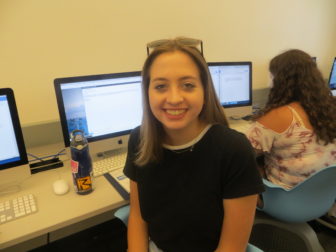Women had just 37 percent of the bylines at the 10 most circulated U.S. newspapers in 2015, while just 32 percent of those delivering the evening news at the major TV networks that year were women, according to a major study.
Although 51 percent of the country’s population is female and, according to Nielsen Scarborough, women make up 54 percent of media consumers, gender inequality exists across the media landscape, said the Women’s Media Center in its 2015 report. This includes online and in wire services.
“We can do better. And we must,” said Julie Burton, president of the women’s center, in comments on the group’s website.
Marie Shanahan, assistant professor in the Journalism Department at the University of Connecticut, said women are underrepresented in journalism for a number of reasons.

Sarah Lukowski
For example, Shanahan said, “It could be taxing if you’re a woman and you want to start a family. This is a hard job to have. So that may reflect on some of the numbers.”
Men received 68 percent of bylines at the New York Times and Denver Post in 2015, according to the report. Of the 10 newspapers studied, only the Chicago Sun Times had a majority – 55 percent — of bylines by women.
The numbers on gender representation in newspaper newsrooms have been fairly level since 1999, WMC’s 107-page report found. In the case of broadcast journalism in 2015, the numbers dropped from the year before, from 35 percent to 32 percent.
The imbalance must be overcome, Burton and other women journalists say.
Media is a powerful tool, experts say: It allows people to connect, to get educated and to form their own opinions. Diversifying media is crucial to the cultural landscape.
“We hope that one good result of releasing these discouraging numbers will be that media can take a hard look at their newsrooms and make changes to improve the ratios in their reporting,” said Burton.
PBS exceeded expectations where women were in the anchor’s chair for evening broadcasts 97 percent of the time, according to the WMC report — far better than ABC, CBS and NBC.
The inequality is also shown in major internet news outlets such as CNN, Fox News and the Daily Beast. Huffington Post is the only online website mentioned in the report as exceeding parity — with 53 percent of female bylines.
Shanahan said that inequalities become more evident as women seek careers in journalism.
“I’m not seeing it at UConn at this level, but when you graduate and get into the actual industry itself, I would say that those disparities still exist and persist, which is proven by this report on a yearly basis,” she said. She explained that she was referring to the number of women in UConn’s journalism program compared with the number of women in professional journalism.
Gender inequality extends to salaries. The pay gap in journalism has decreased over time, but less so in recent years, an Indiana University study quoted by the PEW Research Center has found.
In 1970, according to the study, female journalists’ salaries were 64 percent of male journalists’. From 1991 to 2001, women’s salaries were still 81 percent of men’s. In 2012, however, women’s salaries had crept up to just 83 percent of men’s.
Shanahan said that when she started at The Hartford Courant in 1994, her pay was very low in an office that had a majority of men journalists. Shanahan banded together with her women co-workers to compile a gender pay equity study and found that there were major discrepancies. She ended up getting a raise, she said.
The Women’s Media Center report also showed that certain subjects seem to be more commonly written about based on gender. Men are more likely to report on politics, crime, business, science, sports and technology. Women more likely report on education, lifestyle, health and religion. Women have lost further footing in sports reporting: Only 10 percent of women covered sports in 2015 — a decline from 17 percent in 2014.
Gender equity may be “getting better, but it’s just incremental. It’s tiny little footsteps as we go along,” said Shanahan.
“For democracy to function,” Burton said, “people must get the whole story. Democracy itself is at stake.”
Sarah Lukowski is a student at RHAM High School in Hebron, Conn.